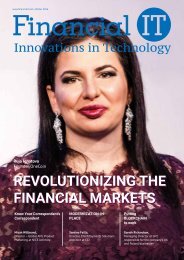Revolutionizing the Financial Markets
Create successful ePaper yourself
Turn your PDF publications into a flip-book with our unique Google optimized e-Paper software.
Winter 2016 Innovation Corner 27<br />
About Chris Larsen<br />
Chris Larsen is CEO and co-founder of Ripple and Chairman<br />
of <strong>the</strong> Board of Directors. Prior to Ripple, Chris cofounded<br />
and served as CEO of Prosper, a peer-to-peer lending<br />
marketplace, and E-LOAN, a publicly traded online lender.<br />
During his tenure at E-LOAN, he pioneered <strong>the</strong> open access<br />
to credit scores movement by making E-LOAN <strong>the</strong> first<br />
company to show consumers <strong>the</strong>ir FICO scores. Chris serves<br />
at <strong>the</strong> Board and Advisory levels at numerous companies<br />
and organizations including: Betable, CreditKarma, and<br />
Electronic Privacy Information Center (EPIC).<br />
That’s because corporations – which make up over 90 percent<br />
of <strong>the</strong> world’s $22.5 trillion annual cross-border payment volume,<br />
according to BCG’s 2014 Global Payments Report – need to set aside<br />
capital in order to access liquidity. The opportunity cost of keeping<br />
all that idle money around is expensive. In all, payment costs add<br />
up to US$1.6 trillion per year, based on <strong>the</strong> global average cost of<br />
international transfers according to <strong>the</strong> Federal Reserve.<br />
The promise of distributed ledgers<br />
The reason today’s system is so inefficient is because <strong>the</strong> world’s<br />
various payment networks aren’t interoperable. They can’t talk to<br />
each o<strong>the</strong>r. So while real-time domestic payments have become a<br />
reality in places like Mexico and <strong>the</strong> U.K. because everyone within<br />
a country is on <strong>the</strong> same system, cross-border payment remains an<br />
ongoing pain point.<br />
Until now, we have relied on a centralized framework for sending<br />
payments. In <strong>the</strong> U.S., for instance, we rely on ACH. This is far<br />
harder to accomplish from an international perspective because it’s<br />
pretty much impossible for everyone to agree on a central counterparty.<br />
Geopolitical realities means that Russia, understandably,<br />
wouldn’t want to give <strong>the</strong> U.S. sovereignty over systemic payments<br />
infrastructure and vice versa.<br />
Distributed ledgers sidestep this issue brilliantly since <strong>the</strong>se<br />
systems don’t require a central operator. In o<strong>the</strong>r words, <strong>the</strong> killer<br />
app that makes efficient cross-border payments possible with <strong>the</strong><br />
Blockchain is its inherent neutrality.<br />
Once adopted, payments facilitated by distributed financial technology<br />
essentially act as a universal protocol, much like SMTP for<br />
email. In that sense, this is <strong>the</strong> payment industry’s email moment.<br />
The benefits of <strong>the</strong>se technologies are transformative, where payments<br />
can now move like information does today. They’re instant,<br />
<strong>the</strong>y’re cheap and perhaps most importantly, come with a sense of<br />
certainty. Unlike today where it’s unclear if a cross-border payment<br />
has gone through, distributed ledger technologies enable you to<br />
know exactly when your transaction is delivered.<br />
The Blockchain bandwagon<br />
While we’ve known about this potential for years, it’s taken time<br />
to not only develop enterprise-grade software but also convince<br />
traditionally risk-averse financial institutions to experiment with<br />
radical new technology. That’s why this year’s Sibos was so exciting.<br />
If banks were wary about Blockchain in 2014, keeping it at arm’s<br />
length, 2015 was when <strong>the</strong>y officially joined <strong>the</strong> party. The main<br />
question from banks had evolved from “What is Blockchain?” to<br />
“How do we leverage it?”<br />
It was clear at <strong>the</strong> conference that banks are waking up to <strong>the</strong><br />
need to adopt agile methodologies to foster innovation. The next<br />
step, <strong>the</strong>n, is to start testing new technologies and provide real<br />
products and services to customers. The urgency was palpable.<br />
There’s an understanding that customer expectations are shifting in<br />
<strong>the</strong> digital age.<br />
It was also a great Sibos for Ripple, as we unveiled <strong>the</strong> industry’s<br />
first suite of enterprise-grade payments products powered<br />
by distributed ledgers, which were tested through rigorous proofof-concepts<br />
by dozens of banks over <strong>the</strong> past year. The software is<br />
plug-and-play and connects any institution to a global network of<br />
banks and market makers allowing direct bank-to-bank settlement.<br />
Faster, certain payments might seem trivial to some but <strong>the</strong>se are<br />
<strong>the</strong> fundamental building blocks of <strong>the</strong> global economy. Moreover,<br />
we believe this to be <strong>the</strong> birth of <strong>the</strong> Internet of Value, which will<br />
bring untold innovation, unleash previously untapped potential and<br />
productivity, and expand access to more people than ever before.







